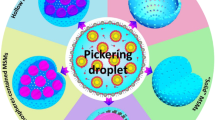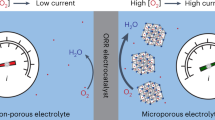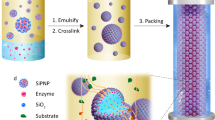Abstract
Multiphase catalysis is used in many industrial processes; however, the reaction rate can be restricted by the low accessibility of gaseous reactants to the catalysts in water, especially for oxygen-dependent biocatalytic reactions. Despite the fact that solubility and diffusion rates of oxygen in many liquids (such as perfluorocarbon) are much higher than in water, multiphase reactions with a second liquid phase are still difficult to conduct, because the interaction efficiency between immiscible phases is extremely low. Herein, we report an efficient triphase biocatalytic system using oil core–silica shell oxygen nanocarriers. Such design offers the biocatalytic system an extremely large water-solid-oil triphase interfacial area and a short path required for oxygen diffusion. Moreover, the silica shell stabilizes the oil nanodroplets in water and prevents their aggregation. Using oxygen-dependent oxidase enzymatic reaction as an example, we demonstrate this efficient biocatalytic system for the oxidation of glucose, choline, lactate, and sucrose by substituting their corresponding oxidase counterparts. A rate enhancement by a factor of 10–30 is observed when the oxygen nanocarriers are introduced into reaction system. This strategy offers the opportunity to enhance the efficiency of other gaseous reactants involved in multiphase catalytic reactions.

Similar content being viewed by others
References
Climent, M. J.; Corma, A.; Iborra, S. Heterogeneous catalysts for the one-pot synthesis of chemicals and fine chemicals. Chem. Rev. 2011, 111, 1072–1133.
Zhou, H.; Sheng, X.; Xiao, J.; Ding, Z. Y.; Wang, D. D.; Zhang, X. Q.; Liu, J.; Wu, R. F.; Feng, X. J.; Jiang, L. Increasing the efficiency of photocatalytic reactions via surface microenvironment engineering. J. Am. Chem. Soc. 2020, 142, 2738–2743.
Huang, J. P.; Cheng, F. Q.; Binks, B. P.; Yang, H. Q. pH-responsive gas-water-solid interface for multiphase catalysis. J. Am. Chem. Soc. 2015, 131, 15015–15025.
Kandemir, T.; Schuster, M. E.; Senyshyn, A.; Behrens, M.; Schlogl, R. The haber-bosch process revisited: On the real structure and stability of “ammonia iron” under working conditions. Angew. Chem., Int. Ed. 2013, 52, 12723–12726.
Kang, P.; Zhang, S.; Meyer, T. J.; Brookhart, M. Rapid selective electrocatalytic reduction of carbon dioxide to formate by an iridium pincer catalyst immobilized on carbon nanotube electrodes. Angew. Chem., Int. Ed. 2014, 53, 8709–87013.
Herkendell, K.; Stemmer, A.; Tel-Vered, R. Extending the operational lifetimes of all-direct electron transfer enzymatic biofuel cells by magnetically assembling and exchanging the active biocatalyst layers on stationary electrodes. Nano Res. 2019, 12, 767–775.
Shi, J. Y.; Clayton, C.; Tian, B. Z. Nano-enabled cellular engineering for bioelectric studies. Nano Res. 2020, 13, 1214–1227.
Yang, X. H.; Li, Z. P.; Kitta, M.; Tsumori, N.; Guo, W. H.; Zhang, Z. T.; Zhang, J. B.; Zou, R. Q.; Xu, Q. Solid-solution alloy nanoclusters of the immiscible gold-rhodium system achieved by a solid ligand-assisted approach for highly efficient catalysis. Nano Res. 2020, 73, 105–111.
Liu, C.; Colon, B. C.; Ziesack, M.; Silver, P. A.; Nocera, D. G. Water splitting-biosynthetic system with CO2 reduction efficiencies exceeding photosynthesis. Science 2016, 352, 1210–1213.
Shi, R.; Guo, J. H.; Zhang, X. R.; Waterhouse, G. I. N.; Han, Z. J.; Zhao, Y. X.; Shang, L.; Zhou, C.; Jiang, L.; Zhang, T. R. Efficient wettability-controlled electroreduction of CO2 to CO at Au/C interfaces. Nat. Commun. 2020, 11, 3028.
Shen, S. H.; Chen, J.; Wang, M.; Sheng, X.; Chen, X. Y.; Feng, X. J.; Mao, S. S. Titanium dioxide nanostructures for photoelectrochemical applications. Prog. Mater. Sci. 2018, 98, 299–385.
Xiong, X. Y.; Wang, Z. P.; Zhang, Y.; Li, Z. H.; Shi, R.; Zhang, T. R. Wettability controlled photocatalytic reactive oxygen generation and Klebsiella pneumoniae inactivation over triphase systems. Appl. Catal. B 2020, 264, 118518.
Lei, Y. J.; Sun, R. Z.; Zhang, X. C.; Feng, X. J.; Jiang, L. Oxygen-rich enzyme biosensor based on superhydrophobic electrode. Adv. Mater. 2016, 28, 1477–1481.
Song, Z. Q.; Xu, C. L.; Sheng, X.; Feng, X. J.; Jiang, L. Utilization of peroxide reduction reaction at air-liquid-solid joint interfaces for reliable sensing system construction. Adv. Mater. 2018, 30, 1701473.
Heller, A.; Feldman, B. Electrochemical glucose sensors and their applications in diabetes management. Chem. Rev. 2008, 108, 2482–2505.
Mi, L.; Yu, J. C.; He, F.; Jiang, L.; Wu, Y. F.; Yang, L. J.; Han, X. F.; Li, Y.; Liu, A. R.; Wei, W. et al. Boosting gas involved reactions at nanochannel reactor with joint gas-solid-liquid interfaces and controlled wettability. J. Am. Chem. Soc. 2017, 139, 10441–10446.
Wang, J. Electrochemical glucose biosensors. Chem. Rev. 2008, 108, 814–825.
Cheng, X. Q.; Zhou, J. H.; Chen, J. Y.; Xie, Z. X.; Kuang, Q.; Zheng, L. S. One-step synthesis of thermally stable artificial multienzyme cascade system for efficient enzymatic electrochemical detection. Nano Res. 2019, 12, 3031–3036.
Junker, B. H.; Hatton, T. A.; Wang, D. I. C. Oxygen transfer enhancement in aqueous/perfluorocarbon fermentation systems: I. Experimental observations. Biotechnol. Bioeng. 1990, 35, 578–585.
Costa Gomes, M. F.; Deschamps, J.; Menz, D. H. Solubility of dioxygen in seven fluorinated liquids. J. Fluorine Chem. 2004, 125, 1325–1329.
Riess, J. G. Oxygen carriers (“blood substitutes”)-raison d’etre, chemistry, and some physiology. Chem. Rev. 2001, 101, 2797–2920.
Song, X. J.; Feng, L. Z.; Liang, C.; Yang, K.; Liu, Z. Ultrasound triggered tumor oxygenation with oxygen-shuttle nanoperfluorocarbon to overcome hypoxia-associated resistance in cancer therapies. Nano Lett. 2016, 16, 6145–6153.
Castro, C. I.; Briceno, J. C. Perfluorocarbon-based oxygen carriers: Review of products and trials. Artif. Organs. 2010, 34, 622–634.
Scott, M. G.; Kucik, D. F.; Goodnough, L. T.; Monk, T. G. Blood substitutes: Evolution and future applications. Clin. Chem. 1997, 43, 1724–1731.
Westbrook, A. W.; Ren, X.; Moo-Young, M.; Chou, C. P. Application of hydrocarbon and perfluorocarbon oxygen vectors to enhance heterologous production of hyaluronic acid in engineered Bacillus subtilis. Biotechnol. Bioeng. 2018, 115, 1239–1252.
Taskin, M. B.; Klausen, L. H.; Dong, M. D.; Chen, M. L. Emerging wet electrohydrodynamic approaches for versatile bioactive 3D interfaces. Nano Res. 2020, 13, 315–327.
Zhu, H. F.; Xie, H.; Yang, Y.; Wang, K. Y.; Zhao, F.; Ye, W. X.; Ni, W. H. Mapping hot electron response of individual gold nanocrystals on a TiO2 photoanode. Nano Lett. 2020, 20, 2423–2431.
Kamin, R. A.; Wilson, G. S. Rotating ring-disk enzyme electrode for biocatalysis kinetic studies and characterization of the immobilized enzyme layer. Anal. Chem. 1980, 52, 1198–1205.
Ngian, K. F.; Lin, S. H.; Martin, W. R. B. Effect of mass transfer resistance on the lineweaver-burk plots for flocculating microorganisms. Biotechnol. Bioeng. 1977, 19, 1773–1784.
Hamilton, B. K.; Gardner, C. R.; Colton, C. K. Effect of diffusional limitations on lineweaver–burk plots for immobilized enzymes. AIChE J. 1974, 20, 503–510.
Acknowledgements
This research was financially supported by the National Key R&D Program of China (No. 2019YFA0709200) and the National Natural Science Foundation of China (Nos. 21988102, 51772198, and 21975171).
Author information
Authors and Affiliations
Corresponding authors
Electronic Supplementary Material
Rights and permissions
About this article
Cite this article
Zhou, L., Chen, L., Ding, Z. et al. Enhancement of interfacial catalysis in a triphase reactor using oxygen nanocarriers. Nano Res. 14, 172–176 (2021). https://doi.org/10.1007/s12274-020-3062-8
Received:
Revised:
Accepted:
Published:
Issue Date:
DOI: https://doi.org/10.1007/s12274-020-3062-8




